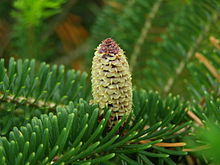Fraser fir
| Abier takis | |
|---|---|
 |
|
| Foliage and cone | |
| Scientific classification | |
| Kingdom: | Plantae |
| Division: | Pinophyta |
| Class: | Pinopsida |
| Order: | Pinales |
| Family: | Pinaceae |
| Genus: | Abies |
| Species: | A. fraseri |
| Binomial name | |
|
Abies fraseri (Pursh) Poir., 1817 |
|
 |
|
| Natural range of Abies fraseri | |
 |
|
| Synonyms | |
|
|
The Fraser fir, Abies fraseri, is a species of fir native to the Appalachian Mountains of North Carolina and other states in the eastern U.S.
Abies fraseri is closely related to balsam fir (Abies balsamea), of which it has occasionally been treated as a subspecies (as A. balsamea subsp. fraseri (Pursh) E.Murray) or a variety (as A. balsamea var. fraseri (Pursh) Spach).
The species Abies fraseri is named after the Scottish botanist John Fraser (1750–1811), who made numerous botanical collections in the region. It is sometimes misspelled "Frasier," "Frazer" or "Frazier."
In the past, it was also sometimes known as "she-balsam" because resin could be "milked" from its bark blisters, in contrast to the "he balsam" (red spruce) which could not be milked. It has also occasionally been called balsam fir, inviting confusion with A. balsamea.
Abies fraseri is a small evergreen coniferous tree typically growing between 30 and 50 feet (10–15 m) tall, but rarely to 80 ft (25 m), with a trunk diameter of 16 to 20 inches (40–50 cm), but rarely 30 in (75 cm). The crown is conical, with straight branches either horizontal or angled upward at 40° from the trunk; it is dense when the tree is young and more open in maturity. The bark is thin, smooth, grayish brown, and has numerous resinous blisters on juvenile trees, becoming fissured and scaly in maturity.
The leaves are needle-like; arranged spirally on the twigs but twisted at their bases to form 2 rows on each twig; they are 0.4-0.9 inches (10–23 mm) long and 79-87 mil (2–2.2 mm) broad; flat; flexible; rounded or slightly notched at their apices (tips); dark to glaucous green adaxially (above); often having a small patch of stomata near their apices; and having 2 silvery white stomatal bands abaxially (on their undersides). Their strong fragrance resembles turpentine.
...
Wikipedia

